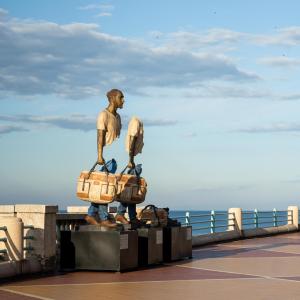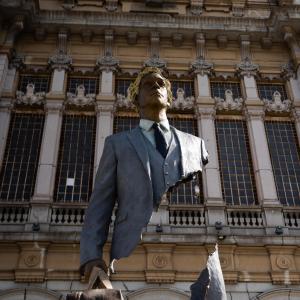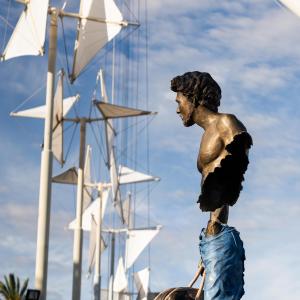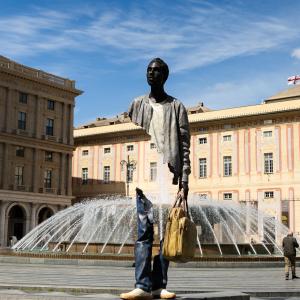"I travelled as well with suitcases full of memories. They don't just contain images...
they are my origins on the go”.
"In the suitcase, there are memories, nostalgia, the burden of life, constraints, but also hopes, pride and the desire to travel, to live".
Bruno Catalano
Bruno Catalano was born in Khouribga (Morocco) in 1960, with mixed and Mediterranean descents. In 1975 he faced a forced exile with his family. He landed in Marseille hoping to start a brand-new life, still preserving the memory of the pain of his uprooting. At 18 he firstly became a sailor, then an electrician, and at 30 he came across art and clay sculpture through artists such as Rodin, Giacometti, César. Thereafter, he decided to dedicate his life to it. First noticed in 2005 by a Parisian gallery owner at a contemporary art exhibition, then he evolved from clay to bronze, and he sculpted bigger and bigger figures, thus achieving remarkable technical feats. Today he lives and works between France and Italy and his "Travellers" enrich the most prestigious public and private collections.
The Travelers by Bruno Catalano
Bruno Catalano's “The Travelers” depict characters immortalized in the midst of a mysterious journey, the duration, origin, and destination of which remain unknown. Catalano selects men and women from ordinary life, transforming them into heroic figures that symbolize continuity and transformation. Through their monumental presence, these sculptures explore universal themes of human existence such as identity, migration, and life's journey. Each figure carries baggage—fragments of their personal histories—and is depicted in a precarious balance between past roots and future aspirations.
In Catalano's art, these individuals are portrayed as suspended figures in motion, traversed by light, wind, and contemplative gazes. Their bodies are incomplete, with missing parts that serve as windows reflecting selfrecognition, acting as metaphors for the ongoing movement and connection inherent in life's journey.
Simone - Stazione Brignole
In “Simone,” Bruno Catalano has crafted a full-length portrait of a young Venetian whose characteristic lacerations embody Italian elegance, a hallmark of his Travelers series. Dressed in a suit with a tie, Simone's silhouette exudes elaborate sobriety. Two bright bronze accents stand out against his gray-toned attire: one on his hand gripping a large leather bag, and the other on his face. With a serene expression, his gaze reflects confidence and determination, projecting towards the future.
Khadine - Piazza De Ferrari
"Khadine," a recurring character in Catalano's Travelers series and a friend of the artist, strides with calm confidence, suitcase in hand, seemingly gazing towards a distant horizon. This portrayal reflects the experience of a Senegalese man navigating between countries and continents, paralleling the broader African diaspora and the intertwining of past and present legacies in a globalized world.
Hubert - Calata Falcone Borsellino
Standing, waiting, "Hubert" has been immortalized in a moment of absence where his spirit hovers elsewhere. He stands in a moment of contemplative absence, dressed simply in jeans with a bare torso and feet. His bronzetoned skin, exposed to the sun and elements, contrasts against the blue of his pants. Despite the void left by his missing parts, Hubert's posture evokes the essence of Greco-Roman statuary, with a casually inserted hand in his pocket conveying a carefree youthfulness.
Benoît - Piazza De Ferrari
When crafting each of the Travelers, Bruno Catalano sees in his subjects, whether man or woman, a glimmer of inspiration: a gaze, an expression, a stature, a detail. He discovers in them the strength, originality, and humanity of a work of art. Such is the case with "Benoît," a colleague and friend of Bruno Catalano at the art foundry. Benoît's appearance and expression recall mythological figures of antiquity—an anachronistic presence intertwined with the present's frenetic rhythms, emphasizing the timeless nature of Catalano's artistic vision.
Pierre David Tryptique - Corso Italia
Traces of a journey that are both mobile and immobile becausethe Traveler is not only the one who has left everything for a dream and elsewhere. It is also the one who, suitcase in hand, well-dressed, standing upright, represents each of us at our best. With this idea in mind, Bruno Catalano created "Pierre David Triptyque.” Whatever our itinerary, here is what will remain of us, ephemeral travelers on this Earth: some traces of wornout, derisory matter. A pair of shoes, a suitcase, symbols of each person’s legacy after their passage. As he matures, much of Catalano’s work showcases the passage of time; with "Pierre David Triptyque," he proposes a raw and eloquent emblem of our mortality, being simple travelers of life.

Bruno Catalano
The Metaphor of Travel
Enzo Di Martino
Bruno Catalano's plas.c works might be disorien.ng at first glance, because the French sculptor - born in Morocco from an Italian family - uses an unusual and surprising expressive strategy that shaCers his figures' integrity.
This necessarily forces viewers to critically consider the historic crisis of sculpture; it was roundly denounced by Rodin and Medardo Rosso in the late 1800s, then enshrined in Boccioni's transgressive and revolutionary 1912 "Manifesto of futurist sculpture", and finally definitively expressed by Arturo Martini in 1945 when he famously warned that sculpture was a "dead language" Happily, this expressive crisis actually led only to the end of statuary and the celebra.ve func.on of sculpture, which was no longer used to represent historic values and symbolic meanings in the "decorative" function of urban spaces to visually glorify the events and people preserved in our collective memory. From that point on, plastic arts were freed to seek new and more adventurous expressive forms, manifesting the many revolutionary formal appearances that emerged from this language throughout the 20th century. They also express a renewed poetry through the materials used; no longer restricted to the rigid classicism of marble, they turned first to bronze, then to other, often less noble materials, and in more recent expressions, even unpleasant and perishable ones. What did not change, however, and was perhaps made more difficult, was sculpture's historic utopian ambition to significantly and harmoniously occupy space, whether outdoors, in the open, or in a closed environment.
A modern artist, i.e. contemporary to himself, Bruno Catalano naturally acknowledges the historic situation of sculpture's crisis in his time. Perhaps because of one of those "genial coincidences" of art over the course of history, he has found his own personal and unusual form of expression through a new conception of plastic arts, strongly defined by the fracturing of the figure and a failure to define certain parts of it. So, his sculptures appear incomplete at first glance, with obviously missing parts. And
observers wonder how Catalano's figures even manage to stand up, since they're often walking with a suitcase or handbag in their hands. Yet, despite being "mutilated" in this way, his sculptures still retain all of the seductive aesthetic and formal possibilities offered by classical plastic works. What's more, they also lead us to a new and surprising reflection the poetry and dialogue with the material, and in his case, with the material that is absent and missing. This absence gives light a new role to play in sculpture, as it passes easily through the figures themselves, illuminating them and eliminating the very physical nature of the material.
Catalano worked with terracotta in his early days, and then bronze in more recent years. So, we might consider his research to be in the material, which he enriches with the significant contribution of the evocative qualities of colour.
Still, because of the way in which they are conceived and created, his sculptures inevitably raise other considerations, including a - perhaps fanciful - Michelangelèsque reflection on the "ideology of the unfinished". They also naturally call for a more or less pertinent consideration of the so-called "poetry of the fragment", though it is justified in a complex historic situation that saw highly unconventional experiments and radical formal gambles in 20th century sculpture. To mention just a few examples, these include Duchamp's shocking 1917 "Fontaine" (a public urinal), Picasso's legendary 1942 "Bull's head" (a bicycle handlebar and seat), the Russian Constructivists' disturbing "mult-material assemblages", Melob's filiform sculpture-environments, the concrete essential nature of Brancusi's figures and Calder's delicate and airy forms suspended in space.
"Walking man" is a recurring title in 20th century sculpture and includes Giacomeb's long and slender mysterious and symbolic figures, to mention just one. Why is this? Because, despite its static nature, sculpture seeks to express movement.
At this point, it is inevitable to note that all of Bruno Catalano's sculptures represent a "walking man", although all of his figures carry a piece of luggage and appear to be anonymous "travellers" going who knows where. This luggage takes various forms: a hard suitcase, a soft duffle bag, a shopping bag, and on one occasion, a guitar case; all are elements that give the traveller uniquely human, psychological and social connotations. So, in a way, they help us "recognise" him.
The ar.st has often pondered about the meaning of his travellers, calling them "people in the world and in time" who, "fractured and destabilised, with no shelter, walk towards salvation or perdition".
This raises new questions on the historic "metaphor of travel", that, as we know, has been fed by numerous literary references over time.
We might even begin with certain legendary voyages in ancient times to reach travellers of the "invisible cities" by Italo Calvino, who stated that "one can travel thousands of miles without ever truly distancing oneself from oneself". And so, the question that Catalano's travellers inevitably raise in the observer's mind is this: who are these travellers and where are they going? This brings to mind the possibility that maybe the true destination of the "travels of men in the world" is home, as Ulysse's myth suggests.
And perhaps, also, as Bruno Catalano's sculptures suggest, they might be returning to the poetic imagination seeking to oppose the supposed "reality of media fictions" of our time that some have defined as "an age of semblances", dramatically lacking in poetry and even in credible truths.







